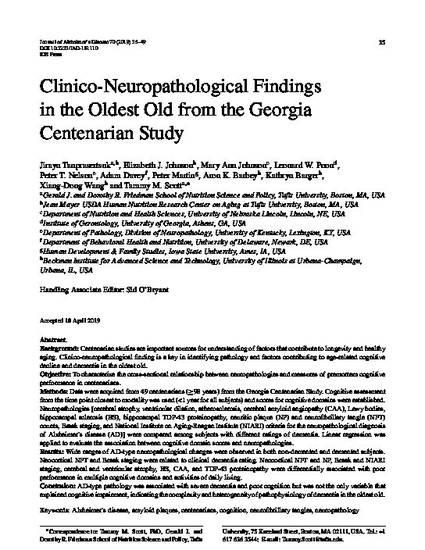
Article
Clinico-Neuropathological Findings in the Oldest Old from the Georgia Centenarian Study
United States Department of Agriculture-Agricultural Research Service / University of Nebraska-Lincoln: Faculty Publications
Date of this Version
4-18-2019
Citation
U.S. government work
Abstract
Background: Centenarian studies are important sources for understanding of factors that contribute to longevity and healthy aging. Clinico-neuropathological finding is a key in identifying pathology and factors contributing to age-related cognitive decline and dementia in the oldest old.
Objective: To characterize the cross-sectional relationship between neuropathologies and measures of premortem cognitive performance in centenarians.
Methods: Data were acquired from 49 centenarians (≥98 years) from the Georgia Centenarian Study. Cognitive assessment from the time point closest to mortality was used (<1 year for all subjects) and scores for cognitive domains were established. Neuropathologies [cerebral atrophy, ventricular dilation, atherosclerosis, cerebral amyloid angiopathy (CAA), Lewy bodies, hippocampal sclerosis (HS), hippocampal TDP-43 proteinopathy, neuritic plaque (NP) and neurofibrillary tangle (NFT) counts, Braak staging, and National Institute on Aging-Reagan Institute (NIARI) criteria for the neuropathological diagnosis of Alzheimer’s disease (AD)] were compared among subjects with different ratings of dementia. Linear regression was applied to evaluate the association between cognitive domain scores and neuropathologies.
Results: Wide ranges of AD-type neuropathological changes were observed in both non-demented and demented subjects. Neocortical NFT and Braak staging were related to clinical dementia rating. Neocortical NFT and NP, Braak and NIARI staging, cerebral and ventricular atrophy, HS, CAA, and TDP-43 proteinopathy were differentially associated with poor performance in multiple cognitive domains and activities of daily living.
Conclusion: AD-type pathology was associated with severe dementia and poor cognition but was not the only variable that explained cognitive impairment, indicating the complexity and heterogeneity of pathophysiology of dementia in the oldest old.
Citation Information
Jirayu Tanprasertsuk, Elizabeth J. Johnson, Mary Ann Johnson, Leonard W. Poon, et al.. "Clinico-Neuropathological Findings in the Oldest Old from the Georgia Centenarian Study" (2019) Available at: http://works.bepress.com/peter-martin/41/

Journal of Alzheimer’s Disease 70 (2019) 35–49 DOI 10.3233/JAD-181110 IOS Press